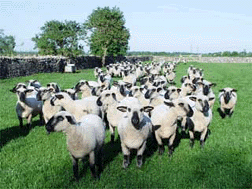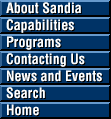FOR IMMEDIATE RELEASE
January 14, 2002
Team studies use of Sandia technology to ensure
‘farm-to-fork’ safety of the nation’s food supply
|

THE DECONTAMINATION FORMULATION is being tested to determine its effectiveness on E. coli, salmonella, and spoilage organisms that may exist
on food-processing equipment.
|
ALBUQUERQUE, N.M. — When farm-to-fork systems fail, billions of dollars can be lost and people can die.
To help prevent such failure, researchers at Sandia National Laboratories, a Department of Energy (DOE) laboratory, is working with several agricultural
universities and agencies to search for ways to apply Labs-developed technology to agricultural and food-safety issues.
“The agricultural infrastructure is a multibillion-dollar industry in the United States,” says Darryl Drayer, who heads up Sandia’s
agricultural security and food safety initiative. “We think it’s important to take technologies that have already been developed at taxpayer
expense and apply them to this industry.”
Drayer is talking about technologies like:
- Decontamination formulation that rapidly neutralizes chemicals and biological warfare agents.
- Rapid Syndrome Validation Project (RSVP) that addresses the identification of naturally occurring or terrorist-caused diseases.
- Rapid modeling and computing capabilities.
- Microsensors that can sense chemicals in water or food.
- Water security and sustainability.
Regina Hunter, one of the researchers working with Drayer on the effort, says that while there are probably other Sandia-developed technologies that can
be applied to making sure food supplies are safe, it’s best to start with those that have the most likelihood of being used immediately.
“Everyone eats,” Hunter says. “We depend on the safe production and processing of agriculture products. That’s why it’s
important to move ahead as rapidly as possible on this initiative.”
Decontamination Foam
Sandia researcher Cecelia Williams is already exploring the possibility with Kansas State University of using the decontamination formulation —
known for its ability to kill anthrax — to eradicate E. coli, salmonella, and spoilage organisms that may exist on food processing
equipment. When used as a foam, the formulation — which is nontoxic, noncorrosive, and looks like shaving cream — may also have the potential
for sanitizing meat cutters’ equipment and sanitizing cattle trucks and poultry houses.
One Kansas State food scientist doing research with the foam found a complete kill of unattached cells of common food-born pathogens. The real test will
come when the foam is used on cells that have actually attached themselves to hard surfaces, such as stainless steel within a processing plant.
“One of the things that we will be looking at with the foam product is its effect when used in the presence of organic materials,” says Randy
Phebus, the lead Kansas State researcher in the project. “For example, if there is organic material left on a [conveyor] belt or floor, does that
inactivate the Sandia formulation in the same way it inactivates other sanitizers, such as bleach?”
Sandia and Kansas State are also investigating other forms of the formulation, like using the solution as a mist in the air.
Before the decontamination foam can be actually used in the food sector, it must receive regulatory approval.
RSVP
Another Sandia technology that might play a role in making sure food supplies are safe is RSVP — a robust, simple, and rapid syndrome-reporting
system for US health care professionals. The algorithm-based software, which takes advantage of Sandia’s rapid modeling and computing capabilities,
is intended to help public health authorities manage common outbreaks of disease, enabling them to recognize an unusual pattern of syndromes that could
warrant special concern or intervention.
Sandia and Kansas State are exploring the possibility of expanding RSVP to stock animals, looking to use it as a way to monitor disease outbreaks in
feedlots, for example.
Sandia scientists Al Zelicoff and Greg Mann have also been working with Kansas State on the project, looking at syndromes in animal populations.
“In Kansas alone, several million head of cattle are routed through feedlots annually,” Hunter says. “Diseases can spread through the
feed lots, at a great cost to the cattle owners. Having the ability to predict potential outbreaks would provide economic value to the cattle industry
and improve food safety for customers.”
Environmental monitoring technologies and remediation
technologies
Sandia has many technologies — like sensors — that could be used to detect contamination of food coming across the border or to monitor the
use of pesticides in the fields to make sure they are not over-applied.
Water security and sustainability
The agriculture industry is one of the biggest users of water. For that reason it is important to ensure the safety, security, and sustainability of
water supplies. Sandia has sensor technologies to monitor the quality of water and has developed systems to detect and correct the vulnerabilities of
water supplies.
In the future, Drayer anticipates that other Sandia technologies will be transferred to agriculture.
“The field is wide open for opportunities to use our technologies,” Drayer says. “We have to explore all the options to see which
technologies are applicable.”
Sandia is a multiprogram laboratory operated by Sandia Corporation, a Lockheed Martin Company, for the United States Department of Energy under contract
DE-AC04-94AL85000. With main facilities in Albuquerque, N.M., and Livermore, Calif., Sandia has major research and development responsibilities in
national security, energy and environmental technologies, and economic competitiveness.
Sandia Media Contact:
Chris Burroughs, coburro@sandia.gov, (505) 844-0948
Sandia Technical Contacts:
Darryl Drayer, dddraye@sandia.gov, (505) 844-8479
Regina Hunter, rlhunte@sandia.gov, (505) 844-5837
| 